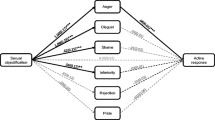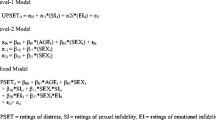Abstract
The aim of this study was to answer the following questions: (1) Are affective responses to sexual rejection different for men and women? (2) Do positive emotions to sexual rejection occur and how do they balance with negative emotions? (3) How can gender differences in affective responses to sexual rejection be explained? A sample of 67 men and 65 women (age 18–30 years) completed a questionnaire in which they rated their affective responses to a hypothetical situation of sexual rejection. Analyses of variance revealed gender differences: men anticipated a less negative and more positive affective response to sexual rejection than women did. Men also reported they would experience a more positive than negative affective response after supposedly being sexually rejected. Hierarchical multiple regression analyses showed that differences between men and women were mediated by the respondents' expectations in the stimulus situation, their interest in casual sex, and their masculinity.
Similar content being viewed by others
REFERENCES
Baumeister, R. F., & Tice, D. M. (2001). The social dimension of sex Boston: Allyn and Bacon.
Baumeister, R. F., Wotman, S. R., & Stillwell, A. M. (1993). Unrequited love: On heartbreak, anger, guilt, scriptlessness, and humiliation. Journal of Personality and Social Psychology, 64, 377-394.
Buss, D. M. (1994). The evolution of desire: Strategies of human mating. New York: Basic Books.
Carroll, J. L., Volk, K. D., & Hyde, J. S. (1985 ). Differences between males and females in motives for engaging in sexual intercourse. Archives of Sexual Behavior, 14, 131-139.
Clark, R. D., & Hatfield, E. (1989). Gender differences in receptivity to sexual offers. Journal of Psychology and Human Sexuality, 2(1), 39-55.
Donald, M., Lucke, L., Dunne, M., & Raphael, B. (1995). Gender differences associated with young people's emotional reactions to sexual intercourse. Journal of Youth and Adolescence, 24, 453-464.
Edgar, T., & Fitzpatrick, M. A. (1993). Expectations for sexual interaction: A cognitive test of the sequencing of sexual communication behaviors. Health Communication, 5, 239-261.
Gagnon, J., & Simon, W. (1973). Sexual conduct: The social sources of human sexuality. Chicago: Aldline.
Guggino, J. M., & Ponzetti, J. J. (1997). Gender differences in affective reactions to first coitus. Journal of Adolescence, 20, 189-200.
Hendrick, S., & Hendrick, C. (1987). Multidimensionality of sexual attitudes. Journal of Sex Research, 23, 502-526.
Hermans, H. J. M. (1974). Waardegebieden en hun ontwikkeling. Amsterdam, The Netherlands: Swets & Zeitlinger.
Herold, E. S., & Mewhinney, D. M. K. (1993). Gender differences in casual sex and AIDS prevention: A survey of dating bars. Journal of Sex Research, 30, 36-42.
Hofstede, G. (1991). Cultures and organizations: Software of the mind. London: HarperCollins.
Hofstede, G. (1998). Masculinity and femininity: The taboo dimension of national cultures. Thousand Oaks, CA: Sage.
Johnson, K. L., & Edwards, R. (1991). The effects of gender and type of romantic touch on perceptions of relational commitment. Journal of Nonverbal Behavior, 15, 43-55.
LaPlante, M. N., McCormick, N. B., & Brannigan, G. G. (1980). Living the sexual script: College students' views of influence in sexual encounters. Journal of Sex Research, 16, 338-355.
Leigh, B. C., Aramburu, B., & Norris, J. (1992). The morning after: Gender differences in attributions about alcohol-related sexual encounters. Journal of Applied Social Psychology, 22, 343-357.
Metts, S., Cupach, W. R., & Imahori, T. T. (1992). Perceptions of sexual compliance-resisting messages in three types of cross-sex relationships. Western Journal of Communication, 56, 1-17.
Muehlenhard, C. L., & Quackenbush, D. M. (1998). Sexual Double Standard Scale. In C. M. Davis, W. L. Yarber, R. Bausermans, G. Schreer, & S. L. Davis (Eds.), Handbook of sexuality-related measures (pp. 186-188). Thousand Oaks, CA: Sage.
Okami, P., & Shackelford, T. K. (2001). Human sex differences in sexual psychology and behavior. Annual Review of Sex Research, 12, 186-241.
Oliver, M. B., & Hyde, J. S. (1993). Gender differences in sexuality: A meta-analysis. Psychological Bulletin, 114, 29-51.
O'Sullivan, L. F., & Byers, E. S. (1996). Gender differences in responses to discrepancies in desired level of sexual intimacy. Journal of Psychology and Human Sexuality, 8(1/2), 49-67.
Schwartz, I. M. (1998). First Coital Affective Reaction Scale. In C. M. Davis, W. L. Yarber, R. Bausermans, G. Schreer, & S. L. Davis (Eds.), Handbook of sexuality-related measures (pp. 127-128). Thousand Oaks, CA: Sage.
Struckman-Johnson, C., & Struckman-Johnson, D. (1993). College men's and women's reactions to hypothetical sexual touch varied by initiator gender and coercion level. Sex Roles, 29, 371-385.
Townsend, J. M. (1995). Sex without emotional involvement: An evolutionary interpretation of sex differences. Archives of Sexual Behavior, 24, 173-206.
Træen, B., & Clift, S. (2000). A qualitative study of Norwegians' accounts of unpleasant sexual encounters. Scandinavian Journal of Sexology, 3, 50-64.
Widmer, E. D., Treas, J., & Newcomb, R. (1998). Attitudes toward nonmarital sex in 24 countries. Journal of Sex Research, 35, 349-358.
Willemsen, T. M., & Fischer, A. H. (1996). Femininiteit en Masculiniteit in Nederland. De ontwikkeling van de Nederlandse Sekse-Identiteit Vragenlijst (NSIV). Tilburg: Katholieke Universiteit Brabant.
Willemsen, T. M., & Fischer, A. H. (1999). Assessing multiple facets of gender identity: The Gender Identity Questionnaire. Psychological Reports, 84, 561-562.
Author information
Authors and Affiliations
Corresponding author
Rights and permissions
About this article
Cite this article
de Graaf, H., Sandfort, T.G.M. Gender Differences in Affective Responses to Sexual Rejection. Arch Sex Behav 33, 395–403 (2004). https://doi.org/10.1023/B:ASEB.0000028892.63150.be
Issue Date:
DOI: https://doi.org/10.1023/B:ASEB.0000028892.63150.be




